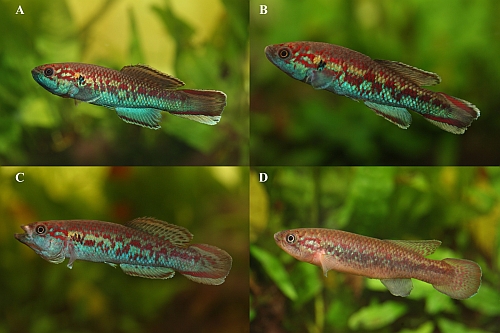
Callopanchax sidibeorum Sonnenberg R. &
Busch E. 2010

Photos reproduced by permission of the papers authors. Photos taken by Eckhard Busch.
| Meaning of Name |
After local collectors - the Sidibe family - Mr Samba Sidibe. |
||
| First Description |
Sonnenberg R. & Busch E. 2010 Description of Callopanchax sidibei (Nothobranchiidae: Epiplateinae), A New Species of Killifish from Southwestern Guinea, West Africa. Bonn zoological Bulletin, volume 57, Issue 1, pp 3-14, April 2010. |
||
| Size |
59·9mm SL (holotype 58·5mm) |
||
| Meristics |
D=19-21, A=17-19, C=29-34, D/A=-2--4, ll=32-34+3-5. |
||
| Karyotype | |||
| Sub-Genus | |||
| Group | |||
| Synonyms |
|
||
Populations
|
|
||
| Type Locality |
Bombokoré, GM 97/2, Guinea. |
||
| Distribution |
Currently only known from the type locality. |
||
| Habitat |
Collected from a depression in the ground with
areas of standing water connected by ditches in secondary forest. Water
is slow flowing & areas of stagnation occur. In 2008 a collection found - air temperature was 31°C, water temperature was 27°C, water depth 60-80cm. The collectors noted fish could be collected from jueveniles to adults whereas the collection in 1997 yielded only fully grown adults. Some adults may migrate from drying pools into main ditch areas. |
||
| Distinguishing Characteristics | Seperated
from C.monroviae by an extra ray in
the dorsal fin. Colouration & pattern differences exist within the sp. |
||
| Colour/Pattern Variability | Although known from a small area only the photos in the original paper suggest some variability. Anal fins in males can be clear turquoise or with a few red spots near the body. The body has variable amounts of red blotches distributed randomly. Caudal fin does show the red submarginal band to end at the rear of this fin (as in most Aphyosemion sp.) or closed around the ending edge forming a crescent. | ||
| History |
Discovered in a commercial shipment to the Nederlands
in 1992. Busch, Wildekamp & Van der Zee all printed articles on
this new fish along with Murphy et al (1999) with a molecular study.
Eckhard Busch made several collecting trips to the collection site to
collect specimens. In a paper entitled - Erratum to: Sonnenberg
& Busch (2010) Description of Callopanchax
sidibei (Nothobranchiidae: Epiplateinae), a new species of
killifish from southwestern Guinea, West Africa |
||
| Breeding Notes |
Little data yet on this sp. but egg incubation is thought to range from 2-9 months. |
||
| Diameter of Egg | |||
| Remarks |
Data originally supplied by Rainer Sonnenberg from the original paper. My sumation - The holotype has a larger lower
outer margin in the caudal fin reminiscent of C.monroviae.
The paratype shown in the photo within the paper shows this to a lesser
degree but may be a younger fish. |